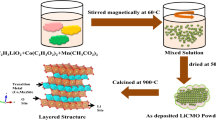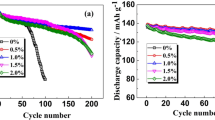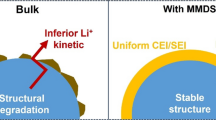Abstract
Low temperature (LT) behavior of graphite/LiNi0.6Co0.2Mn0.2O2 (NCM622) cells prepared with low loading or LL (thinner electrodes prepared with low loading and packing density) and high loading or HL (thicker electrodes prepared with high loading and packing density) were investigated. The cells were prepared as half coin cell, full coin cell, and full pouch cell to identify the main factors that limit LT operations of lithium ion batteries. All the cells were tested at −32 °C, and the capacity retention at LT was compared to the capacity retention at room temperature (RT). The Li+ insertion kinetics was analyzed by electrochemical impedance spectroscopy. The LL electrodes showed a lesser charge transfer resistance (R ct) than that shown by the thicker electrodes at LT. The diffusion coefficients of Li+ calculated via the galvanostatic intermittent titration technique (GITT) in graphite and NCM622 electrodes prepared with LL and HL at RT were in the range of 10−8 cm2/s but decreased to the range of 10−13 and 10−11 cm2/s at −32 °C, respectively. GITT results confirmed that the capacity loss at LT, with increased electrode loading, arose from the limitation of Li-ion diffusion within the electrode.





Similar content being viewed by others
References
Noel M, Santahnam R (1998) Electrochemistry of graphite intercalation compounds: a review. J Power Sources 72:53
Kang K, Meng YS, Breger J (2006) Electrodes with high power and high capacity for rechargeable lithium batteries. Science 311:977–980
Farooq U, Yaqub A, Choi JH (2014) Metal-assisted silicon based negative electrode for Li-ion batteries. Mater Lett 126:291–294
Pervez SA, Kim DH, Seongju S (2013) Improved performance of Ag-nanoparticles-decorated TiO2 nanotubes arrays in Li-ion batteries. J Korean Phys Soc 60:1809–1814
Pervez SA, Kim DH, Farooq U (2014) Crystalline iron oxide nanotubes arrays with high aspect ratio as binder free anode for Li-ion batteries. Phys Status Solidi A. doi:10.1002/pssa.201330537
Tran TD, Feikert JH, Song X (1995) Commercial carbonaceous materials as lithium intercalation anodes. J Electrochem Soc 142:3297–3302
Aurbach D, Ein-Eli Y, Chusid O (1994) The correlation between the surface chemistry and the performance of Li-carbon intercalation anodes for rechargeable ‘Rocking-Chair’ type batteries. J Electrochem Soc 3:603–611
Santhanam R, Rambabu B (2009) Improved high rate cycling of Li-rich Li1.10Ni1/3Co1/3Mn1/3O2 cathode for lithium batteries. Int J Electrochem Sci 4:1770–1778
Zhang SS, Xu K, Jow TR (2003) The low temperature performance of Li-ion batteries. J Power Sources 115:137–140
Park G, Gunawardhana N, Nakamura H (2012) The study of electrochemical properties and lithium deposition of graphite at low temperature. J Power Sources 199:293–299
Zhang SS, Xu K, Jow TR (2002) Low temperature performance of graphite electrode in Li-ion cells. Electrochim Acta 48:241–246
Zhao G, Wei Z, Zhang N (2012) Enhanced low temperature performances of expanded commercial mesocarbon microbeads (MCMB) as lithium ion battery anodes. Mater Lett 89:243–246
Fan J (2003) On the discharge capability and its limiting factors of commercial 18650 Li-ion cell at low temperatures. J Power Sources 117:170–178
Ji Y, Zhang Y, Wang CY (2013) Li-ion cell operation at low temperatures. J. Electrochem Soc 160(4):A636–A649
Nagasubramanian G (2001) Electrical characteristics of 18650 Li-ion cells at low temperatures. J. Appl Electrochem 31:99–104
Patey TJ, Hintennach A, Mantia FL (2009) Electrode engineering of nanoparticles for lithium-ion batteries: role of dispersion technique. J Power Sources 189:590–593
Lestriez B, Ligneel E, Guy D (2007) Advanced materials and methods for lithium ion batteries. Transworld Research Network, Kerala, pp 229–256
Thorat IV, Stephenson DE, Zacharias NA (2009) Understanding rate-limiting mechanisms in LiFePO4 cathodes for Li-ion batteries. J Power Sources 188:592–600
Magasinski A, Dixon P, Hertzberg B (2010) High performance lithium-ion anodes using a hierarchical bottom-up approach. Nat Mater 9(4):353
Zhao K, Pharr M, Vlassak JJ (2010) Fracture of electrodes in lithium-ion batteries caused by fast charging. J Appl Phys 108:73517
Zheng H, Li J, Song X (2012) A comprehensive understanding of electrode thickness effects on the electrochemical performances of Li-ion battery cathodes. Electrochem Acta 71:258–265
Nelson P, Bloom I, Amine K (2002) Design modeling of lithium-ion battery performance. J Power Sources 110:437–444
Lu W, Jansen A, Dees D (2011) High-energy electrode investigation for plug-in hybrid electric vehicles. J Power Sources 196:1537–1540
Wang M, Li J, He X (2012) The effect of local current density on electrode design for lithium-ion batteries. J Power Sources 207:127–133
Doyle M, Fuller TF, Newman J (1993) Modeling of galvanostatic charge and discharge of the lithium/polymer/insertion cell. J Electrochem Soc 140:1526–1533
Srinivasan V, Newman J (2004) Design and optimization of a natural graphite/iron phosphate lithium-ion cell. J Electrochem Soc 151:A1530–A1538
Yoon S, Hwang IK, Lee CW (2011) Power capability analysis in lithium ion batteries using electrochemical impedance spectroscopy. J Electroanal Chem 655:32–38
Tang SB, Lai MO, Lu L (2008) Study on Li+-ion diffusion in nano-crystalline LiMn2O4 thin film cathode grown by pulsed laser deposition using CV, EIS and PITT techniques. Mater Chem Phys 111:149–153
Momma T, Matsunaga M, Mukoyama D (2012) Ac impedance analysis of lithium ion battery under temperature control. J Power Sources 216:304–307
Zhang SS, Xu K, Jow TR (2004) Electrochemical impedance study on the low temperature of Li-ion batteries. Electrochim Acta 49:1057–1061
Tang XC, Song XW, Shen PZ (2005) Capacity intermittent titration technique (CITT): a novel technique for determination of Li+ solid diffusion coefficient of LiMn2O4. Electrochim Acta 50:5581–5587
Pyun SI (2001) Outlines of electrochemistry of materials, Introduction to material electrochemistry. Sigma Press, Rawalpindi
Jung KN, Pyun SI (2007) Effect of pore structure on anomalous behaviour of the lithium inter-calation into porous V2O5 film electrode using fractal geometry concept. Electrochem Acta 52:55453
Jun GH, Hai LX, Ming ZX (2007) Diffusion coefficient of lithium in artificial graphite, mesocarbon microbeads, and disordered carbon. New Carbon Mater 22:7–11
Rui XH, Yesiboltati N, Li SR (2011) Determination of the chemical diffusion coefficient of Li+ in intercalation-type Li3V2(PO4)3 anode material. Solid State Ion 187:58–63
Shuja KM, Rao GVS, Chowdari BVR (2003) Influence of Li-ion kinetics in the cathodic performance of layered Li (Ni1/3Co1/3Mn1/3) O2. J Electrochem Soc 151:A1324–A1332
Prosini PP, Lisi M, Zane D (2002) Determination of the chemical diffusion coefficient of lithium in LiFePO4. Solid State Ion 148:45–51
Park JK (2010) Principles and applications of lithium secondary batteries. Wiley-VCH, Weinheim, pp 238–239
Acknowledgements
This work was supported by the Next Generation Military Battery Research Center Program of The Defense Acquisition Program Administration and Agency for Defense Development.
Author information
Authors and Affiliations
Corresponding author
Rights and permissions
About this article
Cite this article
Yaqub, A., Lee, YJ., Hwang, M.J. et al. Low temperature performance of graphite and LiNi0.6Co0.2Mn0.2O2 electrodes in Li-ion batteries. J Mater Sci 49, 7707–7714 (2014). https://doi.org/10.1007/s10853-014-8479-6
Received:
Accepted:
Published:
Issue Date:
DOI: https://doi.org/10.1007/s10853-014-8479-6




